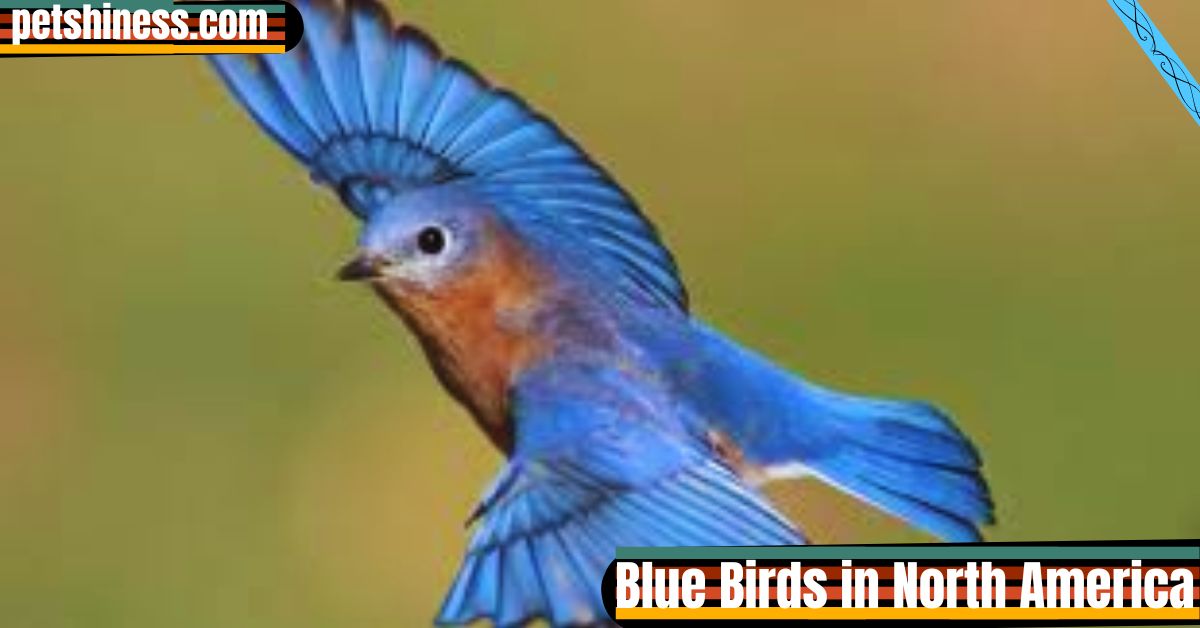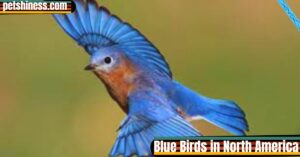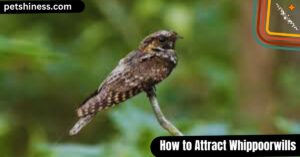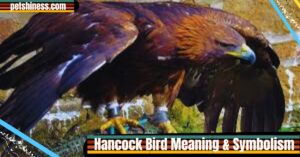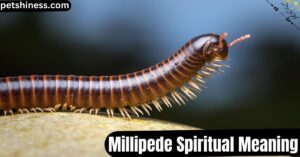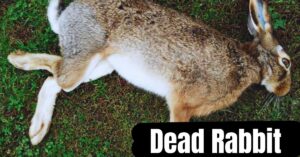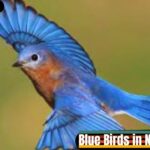Blue birds are fascinating creatures found in North America. They are known for their bright blue feathers, which stand out in various environments, from local meadows to backyards.
The Sialia genus includes several species of bluebirds, such as the Eastern Bluebird and the Western Bluebird. These birds are a common sight in gardens and open spaces across the continent.
The color of a bluebird’s feathers comes from a special scientific process. Unlike other animals, the blue in a bluebird’s feathers does not come from pigments. Instead, it results from the light scattering caused by tiny nanostructures in the feathers.
These structures affect visible light waves, creating a blue tone. The feathers are made of keratin, a strong protein found in hair and nails. This structure gives the bird its stunning blue color.
Bluebirds live in many places across North America. They are often seen in open fields, grasslands, and even suburban backyards. These birds are adapted to various habitats, but they prefer areas with plenty of local meadows.
The birds are mostly found in temperate climates and are not native to the tropical rainforests. However, some species, like the Mountain Bluebird, can be found in higher altitudes during migration.
The blue color of these birds helps them blend in with their surroundings. It also plays a role in attracting mates.
The brighter the blue, the healthier the bird may appear. This is because brighter feathers indicate better quality and stronger genes. The blue feather physics of light reflection helps the birds shine in the sunlight.
In conclusion, bluebirds in North America are amazing birds with beautiful feathers. Their blue coloring comes from the science of light reflection and nanostructures in their feathers.
These birds are found in many environments, from meadows to backyards. Understanding the science behind their coloration adds to their charm and mystery.
1. Eastern Bluebird (Sialia sialis)
The Eastern Bluebird (Sialia sialis) is a blue and orange bird found in the eastern United States. Males have bright blue feathers on their back with an orange belly. Females have more muted colors but still have blue and orange plumage. These birds are often seen in fields, agricultural lands, orchards, and pastures. They also live in open woodlands and even suburban environments. They enjoy sunny, open areas where they can find food and build nests.
The Eastern Bluebird mainly eats insects, spiders, and fruit. They hunt for insects on the ground or from low perches. These birds are migratory and move to Mexico and Central America for the winter.
In spring and summer, they return to the northeastern United States, southeastern Canada, and southeastern United States. The Eastern Bluebird prefers habitats with open spaces and scattered trees, where it can hunt and nest safely.
2. Western Bluebird (Sialia mexicana)
The Western Bluebird (Sialia mexicana) is a colorful bird found in western North America. Males have a bright dark blue head and back with an orange chest and a grey belly. Females have duller colors but still show the blue and orange pattern.
These birds are often seen in fields with scattered trees, open woodlands, and woodland edges. They prefer open habitats where they can hunt for food and build their nests.
The Western Bluebird feeds on insects, fruits, and seeds. They catch insects in the air or find them on the ground. During winter, they eat more fruits and seeds. These birds are known for their altitudinal migration, moving to mountainous areas in summer and descending to lower elevations in winter.
The Western Bluebird lives in the southern United States and Mexico, but its seasonal movements help it survive in different regions. Their migration patterns help them find food throughout the year.
3. Mountain Bluebird (Sialia currucoides)
The Mountain Bluebird (Sialia currucoides) is a stunning bird found in western North America. The male is an electric blue bird with blue wings and a white belly.
The female has more grey-brown feathers and a whitish eye ring. Both have some rufous on the chest.
These birds live in meadows, grasslands, prairies, and tundra edges. They also like alpine hillsides and recently cleared areas or burned areas
Mountain Bluebirds often nest in pastures. They are seen in the northwestern United States and central Mexico during different seasons.
The Mountain Bluebird feeds on insects, spiders, fruits, and seeds. They hunt for food by flying or by searching on the ground. In winter, they focus on fruits and seeds.
Mountain Bluebirds migrate to find food. Their migration patterns help them survive in various climates.
4. Blue Grosbeak (Passerina caerulea)
The Blue Grosbeak (Passerina caerulea) is a large bunting with striking deep blue plumage.
Males have blackish wings and a black face mask, along with rufous wing bars. Non-breeding males and females have duller colors. The bird has a silver and black beak and buffy wing bars.
These birds live in overgrown fields, forest edges, hedgerows, and deserts. They are also found in streamside thickets and savannas
The Blue Grosbeak is common in the southern United States, central United States, northern Mexico, and southern Mexico. During migration, it can be seen in Central America.
The Blue Grosbeak feeds on insects, spiders, seeds, grains, and snails. They are often found foraging on the ground or in low shrubs. These birds enjoy open habitats where they can find plenty of food.
5. Indigo Bunting (Passerina cyanea)
The Indigo Bunting (Passerina cyanea) is a small, colorful bird found in eastern North America. The male has striking blue feathers and dark wings, while the female has brown plumage.
In breeding season, males show vibrant blue colors, but outside breeding, they look duller. Both have a black and grey beak.
These birds live in forest edges, thickets, and brushy fields. They also like weedy fields, open grasslands, and areas with dense trees.
The Indigo Bunting can also be found in orchards, fields, and savannas. During migration, they move to croplands and other open spaces.
The Indigo Bunting feeds on insects, spiders, seeds, and berries. They enjoy eating grass seeds and buds. The bird searches for food in shrubs or on the ground.
These birds migrate to Mexico, Central America, and the Caribbean. They can also be found in northern South America during the winter months. The Indigo Bunting is a migratory bird, moving seasonally across the Americas.
6. Steller’s Jay (Cyanocitta stelleri)
The Steller’s Jay (Cyanocitta stelleri) is a large black and blue bird with a prominent crest. The black fades into dark blue on its body.
Coastal individuals have different markings than interior ones. These birds have white streaking on their crest and chin, with a white mark above the eye.
Steller’s Jays live in forests, woodlands, campgrounds, and picnic sites. They are often found in parks and yards. Their range stretches from Alaska to Nicaragua. These birds thrive in North America and parts of Central America.
The Steller’s Jay has a varied diet. It eats insects, fruits, seeds, nuts, and small mammals. It also feeds on reptiles, eggs, and nestlings. They will scavenge scraps and enjoy suet.
7. Black-throated Blue Warbler (Setophaga caerulescens)
The Black-throated Blue Warbler is a migratory warbler found in forests. The male has a dark blue head and back, with a black face, black throat, and black flanks. His white underside makes him stand out. The female has olive-brown feathers, buffy underparts, and a whitish eyebrow stripe.
These warblers live in deciduous forests, mixed forests, and woodlands. They are also seen in yards, parks, and tropical forests. In the winter, they migrate to the Caribbean and Central America.
The Black-throated Blue Warbler feeds on insects, spiders, fruit, nectar, and seeds. They search for food in trees and shrubs. During migration, they adapt to different food sources in their new habitats.
8. Blue Jay (Cyanocitta cristata)
The Blue Jay is a blue and white bird with a large crest. It has bright blue upper parts and greyish-white underparts.
There is a black necklace around its neck and white wing bars. It also has black barring on its wings and tail. Its white face and black markings in front of the eye make it easy to identify.
Blue Jays live in woodlands, forests, parks, and yards across the eastern United States and southern Canada.
They eat insects, nuts, fruits, seeds, grains, and even eggs or nestlings. These birds are active year-round and are commonly found in their habitats.
9. Cerulean Warbler (Setophaga cerulea)
The Cerulean Warbler is a migratory warbler with a sky-blue back and black streaks. It has dark wings and a greyish-blue rump. Its blue and black tail is easy to spot. The white throat and belly help in identification.
Males have a blue necklace and blue streaks on their flanks, while females are greenish-blue with yellow underparts and a whitish eyebrow stripe.
These warblers live in deciduous forests, tropical forests, and plantations. They can also be found in scrubland and evergreen woodlands. In winter, they migrate to northern South America, including Venezuela, Bolivia, and the eastern Andes.
Their diet consists of insects and plant matter. Cerulean Warblers rely on shade-grown coffee plantations for shelter. This species is important for bird conservation in South America.
10. Florida Scrub Jay (Aphelocoma coerulescens)
The Florida Scrub Jay is an endemic bird found only in Florida, United States. It needs a specific habitat, mainly the Florida scrub habitat, which includes low oak scrub.
This bird has a blue head, blue wings, and a blue tail. Its body is grey, with a whitish forehead and a blue-grey bib.
These birds eat acorns, insects, berries, seeds, small mammals, birds, and reptiles. The Florida Scrub Jay is important for conservation efforts in Florida. It thrives in the scrub ecosystem and is a key species in maintaining its habitat.
11. Lazuli Bunting (Passerina amoena)
The Lazuli Bunting is a beautiful bird found in the northwestern United States, Canada, and parts of western Mexico. During breeding, males have a bright blue head, orange chest, and blackish-grey back.
Their wings and tail are also dark, and they have white wing bars. In non-breeding plumage, males change to a mix of brown and blue, while females are greyish-brown with a grey-blue rump and blue tinges.
These birds live in areas like brushy hillsides, ravines, wooded valleys, and scrubland. They also live near streams and agricultural areas. The Lazuli Bunting enjoys a diet of insects, spiders, seeds, and fruits.
The Lazuli Bunting is a migratory bird, traveling between North America and western Mexico. They are found in areas with thickets and weedy pastures, where they build nests. Their two-toned bill, with a black and greyish color, helps them feed on a variety of foods.
Conclusion
Blue birds in North America are some of the most beautiful and interesting birds. These birds, like the Blue Jay, Indigo Bunting, and Lazuli Bunting, have bright blue feathers that make them easy to spot.
They live in many different places, from forests and woodlands to fields and gardens. Their bright colors help them stand out in nature, and they play important roles in their habitats.
Many blue birds in North America are migratory. They move to different areas during the year to find food and better living conditions. These birds feed on seeds, insects, fruits, and small mammals.
They are important for controlling insect populations and helping with plant growth. By protecting their natural habitats, we can help ensure these beautiful birds continue to thrive.
FAQ.s
1. What are Blue Birds in North America?
Blue birds in North America include species like the Blue Jay, Indigo Bunting, and Lazuli Bunting, known for their vibrant blue feathers and widespread habitats.
2. Where do Blue Birds in North America live?
These birds are found in forests, woodlands, fields, gardens, and even agricultural areas across North America.
3. Do Blue Birds in North America migrate?
Yes, many blue birds, such as the Indigo Bunting, are migratory and travel to warmer regions during the winter.
4. What do Blue Birds in North America eat?
Blue birds eat seeds, fruits, insects, and sometimes small mammals, helping to maintain healthy ecosystems.
5. Why are Blue Birds in North America important?
Blue birds play key roles in controlling insect populations, promoting plant growth, and supporting biodiversity.
Read Also :
Top Cat Breeders in Scotland – Healthy & Adorable Cats
Perfect Parrot Names: From Classic to Quirky (With Name Generator)
260+ Cool & Catchy Hawk Names With Meanings

Jerry John ensures petshiness.com runs smoothly and securely. With a passion for tech and a focus on user experience, Jerry manages the site to deliver top-notch content and functionality.
